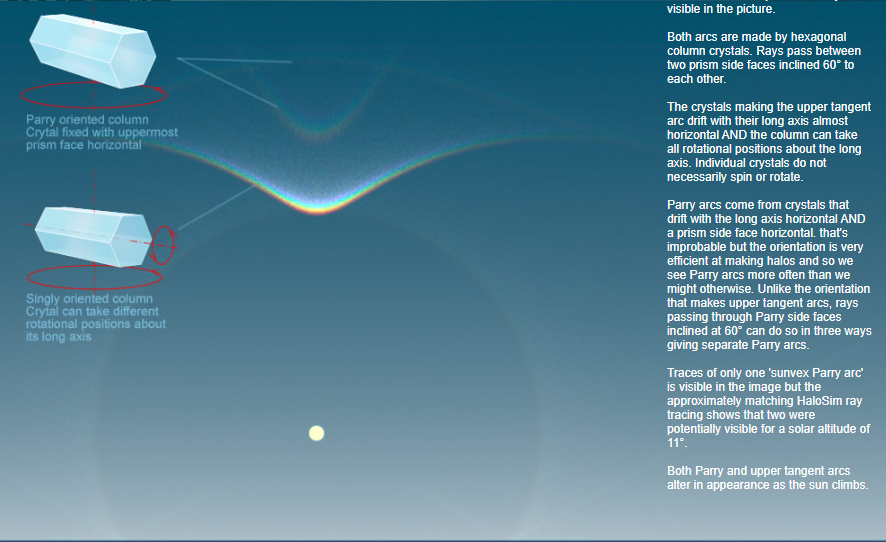Halo & Contrail
Halo & Contrail: A Fascinating Atmospheric Optics Phenomenon
Atmospheric optics never fails to captivate us with its mesmerizing displays of light and color. One such phenomenon that often leaves us in awe is the halo, accompanied by its celestial companion, the contrail. While many of us may be familiar with the 22° halo and sundogs, the upper tangent arc and Parry arc are equally intriguing and less commonly observed.
The upper tangent arc, seen as a bright arc in the image above, ranks as the third most common halo after sundogs and the 22° halo. What makes its appearance in this image particularly unique is its solitary presence without the accompaniment of a conspicuous 22° halo. The upper tangent arc, along with the rarer Parry arc, is formed by hexagonal column crystals. Rays of light pass between two prism side faces that are inclined at an angle of 60° to each other.
When encountering a well-defined upper tangent arc, it is worth directing our gaze upwards to search for the elusive Parry arc. In the provided image, a faint Parry arc is just visible. The crystals responsible for the Parry arc drift with their long axis almost horizontal, while a prism side face remains horizontal. This orientation may seem improbable, but it is remarkably efficient at producing halos, making Parry arcs more frequently observed than one might expect. Unlike the orientation that generates upper tangent arcs, rays passing through Parry side faces inclined at 60° can do so in three different ways, resulting in separate Parry arcs.
As the sun climbs higher in the sky, both Parry and upper tangent arcs undergo transformations in appearance. These changes in the arcs' characteristics add to their allure and make them even more captivating to observe.
Contrails, short for "condensation trails," are another fascinating element often found alongside halos. Contrails are the visible trails left behind by aircraft flying at high altitudes. These trails consist of tiny ice crystals or water droplets that form due to the exhaust emissions of aircraft engines. Contrails can create stunning visual effects when intersecting with halos, enhancing the overall atmospheric optics spectacle.
To summarize the key points about halo and contrail phenomena:
- The upper tangent arc is a bright arc often observed as the third most common halo.
- Parry arcs are rarer than the upper tangent arc but more frequently observed due to their efficient orientation for halo formation.
- Both arcs are created by hexagonal column crystals with specific orientations.
- Rays of light pass between prism side faces inclined at 60° for both arcs.
- Upper tangent arcs and Parry arcs exhibit different appearances as the sun's altitude changes.
- Contrails, formed by aircraft engine emissions, can intersect with halos, adding an extra layer of beauty to atmospheric optics displays.
As we gaze up at the sky, it is essential to appreciate the intricate dance of light and atmospheric conditions that create these stunning optical phenomena. The halo and contrail combination offers us a glimpse into the wonders of our atmosphere and reminds us of the boundless beauty that surrounds us. So next time you spot a halo in the sky, take a moment to marvel at its intricate details and contemplate the magic happening above us.
 Halo Pair imaged by Charley Hale in Lafayette, Colorado, USA.�Charley Hale, shown with permission.
Halo Pair imaged by Charley Hale in Lafayette, Colorado, USA.�Charley Hale, shown with permission.
The bright arc is the familiar upper tangent arc, perhaps the third most common halo after sundogs and the 22° halo. Its appearance here is unusual because it is unaccompanied by a conspicuous 22° halo.
Whenever a bright and well defined upper tangent arc is seen, look above it for the rarer Parry arc. One is just visible in the picture.
Both arcs are made by hexagonal column crystals. Rays pass between two prism side faces inclined 60° to each other.
The crystals making the upper tangent arc drift with their long axis almost horizontal AND the column can take all rotational positions about the long axis. Individual crystals do not necessarily spin or rotate.
Parry arcs come from crystals that drift with the long axis horizontal AND a prism side face horizontal. that's improbable but the orientation is very efficient at making halos and so we see Parry arcs more often than we might otherwise. Unlike the orientation that makes upper tangent arcs, rays passing through Parry side faces inclined at 60° can do so in three ways giving separate Parry arcs.
Traces of only one 'sunvex Parry arc' is visible in the image but the approximately matching HaloSim ray tracing shows that two were potentially visible for a solar altitude of 11°.
Both Parry and upper tangent arcs alter in appearance as the sun climbs.

Note: this article has been automatically converted from the old site and may not appear as intended. You can find the original article here.
Reference Atmospheric Optics
If you use any of the definitions, information, or data presented on Atmospheric Optics, please copy the link or reference below to properly credit us as the reference source. Thank you!
-
<a href="https://atoptics.co.uk/blog/halo-contrail/">Halo & Contrail</a>
-
"Halo & Contrail". Atmospheric Optics. Accessed on November 26, 2024. https://atoptics.co.uk/blog/halo-contrail/.
-
"Halo & Contrail". Atmospheric Optics, https://atoptics.co.uk/blog/halo-contrail/. Accessed 26 November, 2024
-
Halo & Contrail. Atmospheric Optics. Retrieved from https://atoptics.co.uk/blog/halo-contrail/.